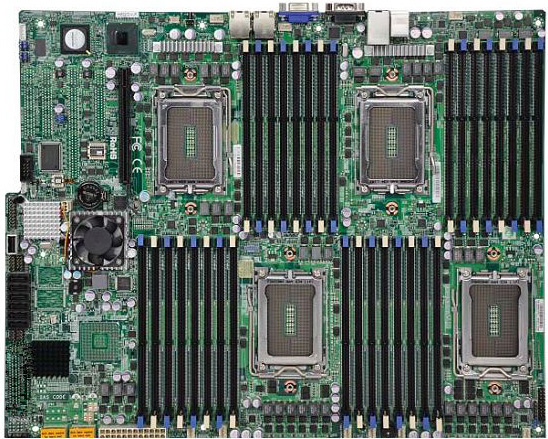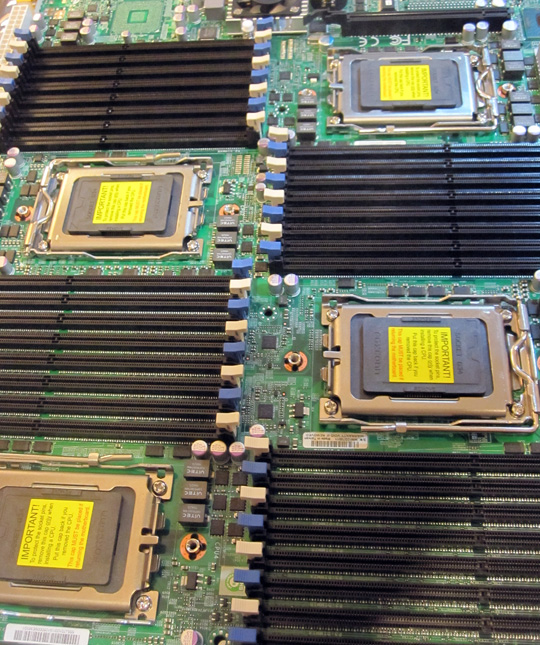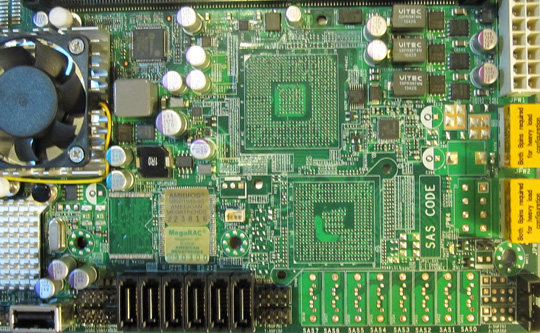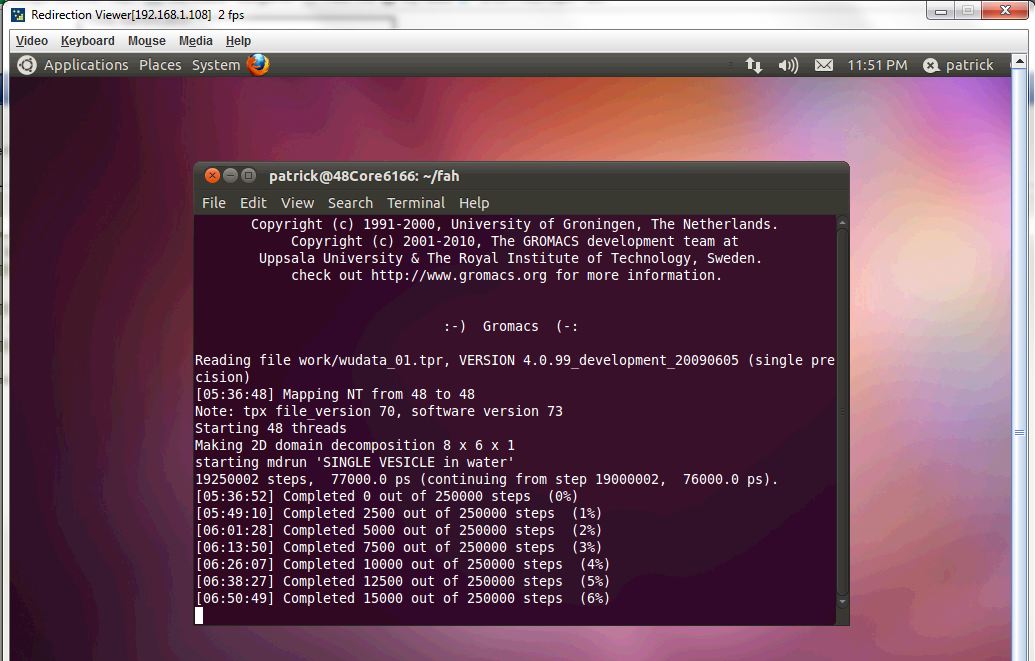As was recently seen with the Opteron 6100 4P platforms, moving to multi-processor systems can yield higher density installations. One challenge motherboard vendors face is that multi-processor designs require more complex traces that cost more to produce. While many users will want full-featured boards with SAS2008 and multiple expansion slots, others just need lower cost processing nodes. The Supermicro H8QGi+-F is currently the lowest-cost 4P G34 platform on the market, and fills the role of a great processing platform quite well.
Test Configuration
I used a very similar test setup to the TYAN S8812WGM3NR swapping out only the motherboard.
- CPUs: 4x AMD Opteron 6166 HE’s
- Motherboard: Supermicro H8QGi+-F
- Memory 16 x 2GB ECC DDR3 UDIMMs
- OS Drive: OCZ Agility 2 120GB
- Enclosure: Norco RPC-470
- Power Supply: Corsair AX850 (850w Gold level power supply)
One thing I noticed is that the 850w 80Plus Gold power supply was easily overkill for this configuration. Power consumption at 100% load on all 48 cores measured around 410-418w.
Board Layout
Like other quad AMD socket G34 boards out there, the Supermicro H8QGi+-F is a very large board using the SWATX form factor. Practically speaking, there is a big difference between the SWATX form factor and EATX form factor in that a SWATX motherboard continues well past the rear I/O slots. For those wondering, the board has dimensions of 16.48″ x 13″ (41.9cm x 33.0cm.)

What this practically means is that the board is large enough that it will fit in very few enclosures. The Norco RPC-470 I used needed to be modified to place the PSU in the front of the chassis because the Supermicro H8QGi+-F extended through the entire PSU area in the rear of the chassis. Supermicro and other vendors offer SWATX compatible enclosures which may be worthwhile given the large form factor.
Expansion slots are hard to come by with the H8QG+-F as the board only has one PCIe x16 slot. It would be completely irresponsible to call this a severe limitation for one important reason: the purpose of this board is purely a combination of cost and CPU compute power, not expansion prowess. Supermicro does offer a wide range and dropping the “+” the H8QGi-F offers many more expansion options at a slightly higher price.

One area where the Supermicro H8QGi+-F and the quad G34 platform excels in is the expandability to large amounts of memory. On the Supermicro H8QGi+-F each Opteron 6100 CPU has eight dedicated memory slots for a total of 32 DDR3 DIMM slots that work in quad channel configurations.Using 16GB DIMMs, one can utilize half a terabyte (512GB) of RAM in the system.

SATA connectivity is provided by six 7-pin SATA connectors that run off of the AMD SP5100 southbridge. One of the tradeoffs in obtaining a high-quality, but low cost motherboard of this caliber is that there is no onboard LSI SAS2008 controller onboard. Since the Supermicro H8QGi+-F is primarily focused with placing many cores (up to 48 cores today with Magny cours and 64 cores later with Interlago) and up to a half terabyte of RAM, having a lot of drive connectivity is not necessarily a priority. If one desires onboard LSI SAS2008 Supermicro offers boards like the H8QG6+-F and H8QG6-F that provide that functionality at a lower cost than purchasing discrete parts.

Network connectivity is handled by an Intel 82576 dual port network controller that provides two Gigabit Ethernet NICs to the system. A. The 82576 is the same controller used in the Intel ET Dual Port Server Adapter, EF Dual Port Server Adapter, and both the ET and ET2 quad port adapters when used in pairs. This is an update to the 82654L used in many previously reviewed boards such as the ASUS P7F-E, Supermicro X8SI6-F, X8SIL-F, X8ST3-F, and the Intel S3420GPLC. Aside from these two Intel ports, Supermicro also includes a third dedicated NIC for IPMI 2.0 access.

Rounding out the rear I/O panel aside from the three NICs are PS/2 keyboard and mouse ports, a serial port, a VGA port, and two USB ports. Frankly, there is little reason to connect more than just Ethernet cabling to the NICs and potentially a USB-based UPS because the included IPMI 2.0 features work well.
Features
Supermicro’s IPMI and KVM-over-IP as described a few times on this site, allows for a lot of deployment flexibility. Things such as fan speeds, chassis intrusion sensors, thermal sensors, and etc. can be monitored remotely and alerts setup to notify the administrator of issues. Beyond this, the Winbond WPCM450 BMC chip also allows for the remote power up, power down, and reset of the server in the event that it becomes unresponsive. In fact, the test system has never had a keyboard, mouse, CD/DVD ROM, or monitor hooked up to it, even after multiple BIOS tweaks and three operating system installations.

Another important feature is the ability to remotely mount CD images and floppy images to the machine over the dedicated management Ethernet controller. This keeps maintenance traffic off of the primary Intel NICs and at the same time removes the need for an optical disk to be connected to the Supermicro H8QGi+-F. Combined with the dual onboard USB 2.0 headers, mounting OS installation or recovery images remotely is a very simple affair.

In combination with the baseboard level management features just described, KVM-over-IP features of the Supermicro H8QGi+-F are not to be underestimated. One can log on to the server using either a web browser with Java platform support, or through Supermicro’s IPMIview software and have remote console capabilities, with mouse support included. Oftentimes, users opine that shell access is enough to troubleshoot, but this BMC level access to the remote system allows one to immediately see things such as a hung and incomplete boot process, frozen servers, as well as manage motherboard and add-in card BIOS remotely. I believe that the IPMI 2.0 features, including the KVM-over-IP features are essential for a server-class motherboard unless one has an external KVM-over-IP unit and a network addressable power source. For users with redundant PSUs, as will be the most common use case with this motherboard, remotely toggling on/ off multiple power supply ports across multiple PDUs can be difficult making the motherboard option preferred.
Conclusion
The Supermicro H8QGi+-F is a great high-quality, low-cost way to setup quad AMD socket G34 systems for heavy computational tasks. While users looking for features such as onboard SAS and additional expansion slots may want to look at other boards in Supermciro’s G34 range, the Supermicro H8QGi+-F stands out as a board priced at approximately $710. Compared to the Tyan S8812 reviewed last week, the Supermicro board is over $120 less expensive. One area where the Supermicro H8QGi+-F is probably the best board on the market is for distributed computing applications like Folding@Home and other compute heavy applications. I actually think the H8QGi+-F is currently the best high-end Folding@Home motherboard available on the market today in terms of cost/ performance when looking at both Intel and AMD platforms. Supermicro’s H8QGi+-F by being the low-cost leader in the market provides lots of value. At approximately twice the cost of dual G34 boards, some applications that favor a single 4P server versus two 2P servers will see great benefits to the board. My only word of advice here is to look carefully at whether one needs extra expansion and if so, there are other Supermicro offerings that will fit the bill at slightly higher costs.




why do you think this 4p board is better than the tyan one for folding?
erick: That is a bit subjective. They have similar performance. The Tyan one has more features than this Supermicro (although Supermicro has other members of this line with similar features as the Tyan.) What this board represents is the lowest-cost 4P G34 board around for folding. It has a lower cost because it does not have things like the LSI SAS2008 controller or a second AMD northbridge for additional PCIe lanes. From a cost/ ppd perspective, this is the best value quad socket G34 board available.
Thanks for the review! Hard to find information about these quad AMD G34 motherboards so the two reviews that you have posted are much appreciated.
Thanks for the review! It’s by far the best bang-for-the buck distributed computing motherboard out there. I bought two, one for BIONIC and one for my company’s labs. We are thinking of doing compute heavy nodes like Facebook’s Open Compute project, but with SSDs and quad socket systems.
Lots of Chassis for huge Motherboards here: http://www.tech-forums.net/pc/f76/faq-list-3u-4u-5u-rackable-towers-full-tower-chassis-cases-hptx-meb-swtx-size-motherboards-244764/
Joe: Great link. One note is that EATX is very easy to find at $80 or less since most 4U chassis will support EATX boards. For larger sizes, the choices are limited.
Interlagos 16 cores support?
lot of images from this review is missing
Thanks for the images heads-up. It looks like it is a ‘+’ character in the image name causing errors on the CDN side. I just checked and the images are sitting in the CloudFront CDN.